In the Developer Survey, in which 65,000 programmers participated in 2020, Python ranked 3rd in the category of the most favorite programming languages.
In the 2021 edition of the Developer Survey involving 80,000 developers, Python ranked 3rd behind JavaScript and HTML/CSS, entry-level technologies.
The Django framework, written in Python, ranked 10th among popular web frameworks in 2020 and 9th most used in 2021.
In 2022, the Django framework maintained its position as the 9th most used framework; however, in 2023, it fell to 13th. It was overtaken by Spring Boot (Java), Flask (Python), ASP.NET (C#, F#, and Visual Basic) and WordPress technologies (PHP).
The Django framework is still very popular among coding learners (6th place in 2023).
As of this article, the 2024 Developer Survey is underway, and we've yet to see how this ranking changes, especially considering the popularity of AI technology.
Year after year, Python and the growing number of frameworks written in Python that improve more than just web development are gaining popularity.
According to a different Developer Ecosystem study conducted by JetBrains, Python is most often used for the following:
- Web development
- Data analysis
- Machine learning
Python and frameworks based on it are also among the most popular languages and tools for programmers to learn and use in their work.
Is this a coincidence? Of course not!
In large, complex, and demanding (in terms of technology or security) projects, Python and web development are terms that are, if not synonymous, then certainly closely tied together.
It's impossible to think about web development without considering Python and its frameworks that significantly facilitate the creation of web applications.
Therefore, it's worth exploring the capabilities that frameworks offer. Some popular frameworks written in Python are worth looking at. Why?
With their help, web development is much faster, simpler, and more efficient, and it guarantees better results both from the technological perspective and the business side related to the user experience.
So there is nothing left to do but invite you to read our — pretty subjective — but helpful review of the top Python frameworks!
As always, we wish you a pleasant reading!
What is web development?
It's appropriate to start by defining the terms when describing and getting acquainted with the capabilities of frameworks and other technologies used for web development.
Web development is the creation of web applications for the following purposes:
- Internet — a globally accessible public network
- Intranet — a non-public, private, and locally accessible network
Web development covers a very different range of work regarding complexity and business relevance related to user experience.
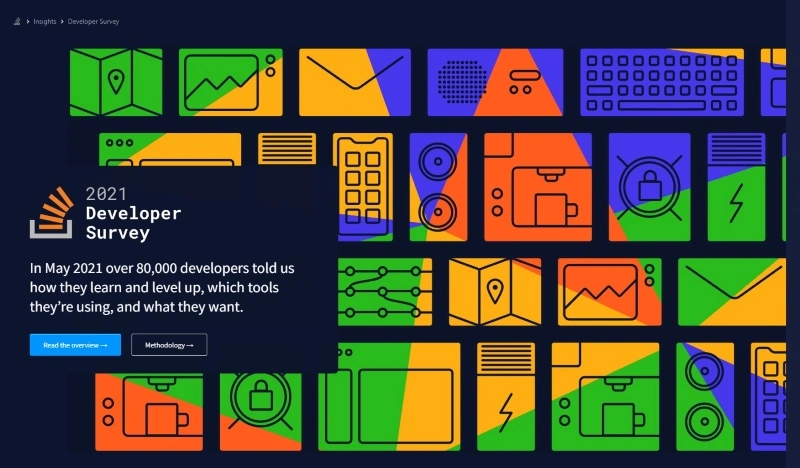
Under this term are, on the one hand, simple showcase pages and blogs. On the other hand, we have web applications that are usually very complex regarding technology, functionality, logic, and business objectives.
Web development is sometimes associated solely with programming work and writing code. Is this the correct approach? It is rather pointless to try to resolve this dilemma. These are — in a sense —academic disputes that are unlikely to make much difference in the daily practice of a web development company.
The web development process uses a whole corpus of tools to make future applications work and look according to users' expectations. And that it is adequate regarding the assumptions its designers and developers made.
The list of tools (regarding programming and design) used in web development includes:
- React.js (JavaScript library)
- Django (framework written in Python)
- Flask, Japronto (microframeworks written in Python)
- Python (one of the most popular programming languages)
- Symfony, Laravel (frameworks written in PHP)
- Material UI, Bulma, Bootstrap (frameworks with ready-made UI components)
- Lottie (JavaScript library for creating interactive vector animations)
- Figma, Sketch, and Zeplin (tools for collaboration between web design and web development teams)
- AWS (the largest cloud provider used to host web applications of any size)
In the list above, we have included the names of selected libraries and frameworks that simplify web application development and web development in general (in the front-end, back-end, Q&A, and DevOps layers).
More efficient, rational, and convenient. Less error-prone, especially in terms of critical errors and security.
They're easy to maintain regarding quality, help keep the project in order with conventions and quality control tools, and are easily submitted to test automation.
A complete list would be much, much longer. At the same time, listing all the tools is not the point. It's an illustration of the extent to which web development today depends (in a good sense) on tools that improve the work in web development companies.
Frameworks (front end, back end) play a special role in modern web development because they provide tested and constantly improved solutions and components.
Frameworks offer clear guidelines for developing applications, which reduce mistakes and eliminate the problem of reinventing the wheel.
Above all, frameworks, including those written in Python, eliminate the problem of creating a web application from scratch. As a result, development teams can deliver finished, high-quality software in a much faster timeframe.
Frameworks written in Python (or other languages) allow developers to quickly create web, mobile, IoT, and other applications without having to build from scratch fundamental operations and processes occurring in the application, such as working with a database or validating user input.
They support most typical programming procedures, thus significantly reducing coding time. They also improve the code's clarity, conciseness, and simplicity, making debugging and maintenance easier. They facilitate the better development of each application layer.
There are two critical layers within web development:
- Front-end web development
- Back-end web development
Front-end layer
Front-end web development addresses the outer layer of a web application, those elements visible to its users (graphics, text, buttons, sliders, etc.) with which they can interact.
Tools supporting front-end web development most often enable us to build a web application's layout more conveniently and efficiently, sometimes with the help of ready-made components, design its interface, and deliver the best UX to users.
Back-end layer
Back-end web development handles the back-end layer of a web application, that is, the part that is not directly accessible to website users and not visible to them. At the same time, it's the heart and brain of the web application.
Back-end web development is responsible for operating a site, collecting, storing, and organizing data, and providing logistical support for the application.
In short, back-end web development makes all web or mobile application components work correctly and allows us to share data between devices and users.
Most front-end and back-end development work is currently done with the help of numerous libraries and frameworks. The main advantage is that the application is built using ready-made modules and templates, resembling building a house.
A vast open-source community ensures frameworks' availability, usefulness, up-to-dateness, and effectiveness. They result from the experience and work of thousands of seasoned engineers worldwide.
The Python community has created a range of helpful frameworks that are constantly being developed, improved, and updated.
With their help, increasingly complex and unusual technological and business problems can be solved in projects of any scale.
So, there is nothing left to do but look at the most popular Python frameworks.
Python web development frameworks: a short introduction
In general, frameworks developed in Python can be divided into two categories:
- Full-stack frameworks
- Microframeworks
Full-stack frameworks allow us to create both layers of an application — front end and back end. The full technology stack makes it possible to develop any application.
Microframeworks have a slightly smaller applicability and more limited capabilities. They contain only the essential elements required to build a very simple web application.
Due to their lightweight nature, they operate much faster than full-stack frameworks. They're an ideal choice for developing high-load applications, i.e., applications used by thousands of users simultaneously.
They won't contain more complex functionalities (such as validation of form fields, ORM, and templates), but this doesn't mean they're unavailable.
Python has lived to see a large number of frameworks that are recommended for projects of various scales and needs (functional and business).
A shared feature of these tools is that they considerably simplify and speed up web development.
Frameworks written in Python are used to create various web applications. They're often used to create, maintain, and develop web applications in the financial, travel, and medical industries.
Python web framework: Django
We have already discussed Django's advantages and usefulness in the articles "The integration of Stripe payments in Django," "Applications developed in Django," and "WordPress vs. Django. What to choose for a corporate website?"
Django is a web framework for perfectionists with deadlines. The official tagline advertising this open-source project fully captures the essence of this tool.
Django owes its reputation to the speed of application development and the smaller amount of code required to create it.
If we want to create a fully working MVP (Minimum Viable Product) with only basic functions seamlessly and quickly, it's worth using Django. This framework helps build efficient and easily scalable applications.
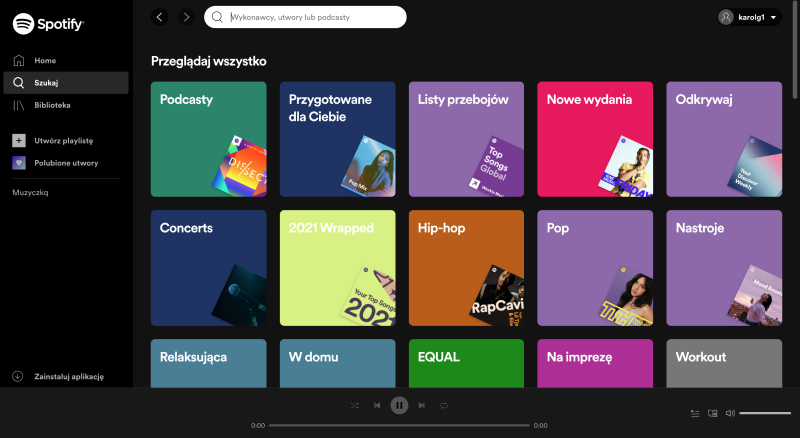
Django (full-stack framework) is recommended for developing complex and large web applications.
Thanks to Django, web development is much more efficient in terms of time and the amount of necessary work.
Django's key features include the following:
- Very good documentation and maturity of the technology
- A large and engaged community that develops the framework and creates countless libraries
- Database version control and an ORM (Object-Relational Mapping) engine
- Support for authentication processes
- Template and view engine, URL caching, and routing
- Convenient panel for the administration of service data with the capability of modification (Django Admin)
- Scalability and speed
- High quality and security
Python web framework: Pyramid
The concise and catchy tagline of yet another framework written in Python also captures its characteristics well. The Start Small, Finish Big, Stay Finished Framework.
Almost all ambitious projects don't shine in terms of momentum and size; instead, they quickly turn into something great, a project that, as it grows in scale, must be relevant to changing needs.
Is it prepared for unexpected success? Yes, if it is created with the help of Pyramid.
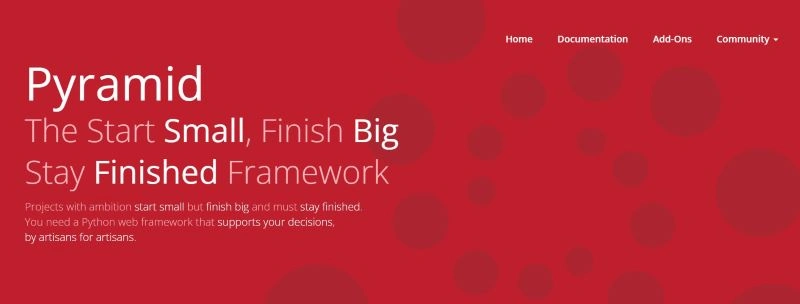
Pyramid was created for such Python web development projects. It was developed to meet different needs and guarantee solutions adequate to each stage of business development.
Pyramid is positioned as an alternative to full-stack and microframeworks.
The first sometimes limits developers too much, while the latter places too much responsibility on them.
Both situations raise the risk of project failure. Pyramid, being somewhere in the middle, guarantees that it can complete any project.
Pyramid's descriptions and evaluations often emphasize its universalism. This framework is recommended for developing complex applications and scaling smaller projects.
It's also appreciated for its flexibility. We can seamlessly swap out any component in Pyramid (e.g., template engine) for another. Pyramid enables the use of multiple components for the same application (e.g., different URL mapping methods).
Python web framework: TurboGears 2
The Web Framework that scales with you — concise and accurate. That is how another framework written in Python, TurboGears 2, self-promotes.

Although it's a framework that would have to be assigned to the microframeworks category, it offers the ability to scale up to a full-stack framework.
The framework was developed in response to the limitations of popular frameworks (Django and its older version, TurboGears 1).
Its latest version is supposed to permit fast development of data-driven web applications.
TurboGears 2 was designed and developed to solve complex performance problems.
TurboGears 2 supports tools such as SQLAlchemy, Genshi, WebOb, and Repoze, which provide high-performance mechanisms for accessing databases or fast templates.
TurboGears 2's key features include the following:
- A powerful ORM (Object-Relational Mapping) engine that supports many types of databases
- The ability to scale the framework to a full-stack solution
- Support for horizontal data partitioning
- Support for multiple data transfer formats
- A designer-friendly template system
- Offering widgets to make it easier to build AJAX (browser-side and server-side) applications
Python web framework: Grok
Grok — Now even cavemen can use Zope 3! — a Python web framework based on the Zope toolkit technology. It's founded on two principles: convention over configuration and don't repeat yourself (DRY).
Grok is an open-source framework for web and application development. It lets developers choose from a variety of libraries, and its user interface can be compared to Python web frameworks like Pylons or Turbo Gears.
This Python framework enables us to develop adaptable web applications and utilize Zope3 technology to its full capabilities. It also provides an object storage database and integrated data security, increasing the security level of apps. Moreover, we can create custom web applications for different purposes, including corporate ones.
Python web framework: Web2Py
Web2Py is a rapid development framework with features such as a debugger, code editor, and deployment instrument for performing tests and application maintenance. Additionally, it supports the following platforms: Windows, Linux, Mac, Google App Engine, Amazon EC2, and web hosting via Python. Moreover, it works with technologies such as SQLite, PostgreSQL, MySQL, and more.
One of the most crucial advantages of this web framework is its capability to generate error tickets, which allows us to track their status easily. It also aids with managing HTTP requests, responses, sessions, and cookies.
We can speed up Python web development using Batteries containing multi-threaded web servers, SQL databases, and web-based interfaces. Furthermore, Web2Py provides a web-based integrated development environment, thanks to which we can create, modify, deploy, and manage applications.
Web2Py counteracts such widespread security vulnerabilities as Cross-Site Scripting, Injection Flaws, and Malicious File Execution.
Thanks to the Model-View-Controller design and Server-Side form validation, the code written with this Python framework is readable, scalable, and easy to maintain. It enables us to create dynamic web content.
Python web framework: Tornado
Tornado is an open-source web framework and asynchronous networking library. It uses a non-blocking I/O framework and can scale to over 10,000 open connections, making it ideal for long pooling, WebSockets, and applications requiring long-lived connections to each user.
It's different from other Python frameworks because it doesn't utilize WSGI and runs with one thread per process.
Its most notable features include:
- Third-party authentication and authorization systems
- High-quality performance
- Real-time services
- Non-blocking HTTP client
- Support in terms of translation and localization
- Web templating
Python microframework: Flask
One drop at a time. This framework's tagline perfectly reflects the philosophy of minimalism that gave birth to it. But this tendency toward minimalism isn't surprising. Flask is one of the more popular microframeworks written in Python.
Flask is equipped with only the necessary tools and mechanisms, making it ideal for creating microservices offered in large web applications.
Flask doesn't include a database abstraction layer or the ability to verify forms. It's oriented toward configuration.
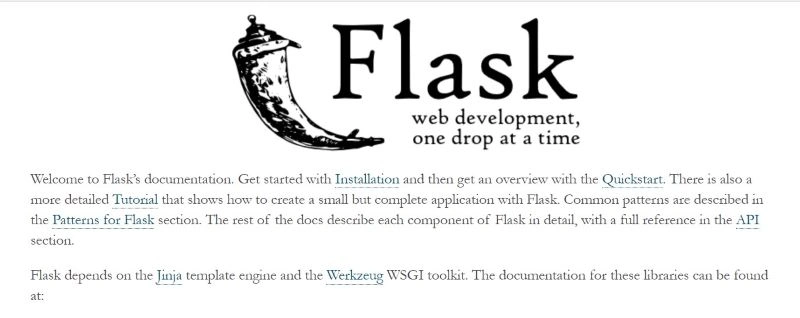
Web development with Flask, whose lightweight, modular design and minimalist architecture support quick and straightforward adaptation of the environment to the project's needs, is very convenient.
Flask is compatible with Google App Engine, among others, and is perfect for developing distributed web applications in the cloud. Basic functionalities, if necessary, can be extended using various libraries, such as Jinja2 or SQLAlchemy.
Flask also provides the following:
- Fast and convenient handling of HTTP queries
- Support for headers, cookies, and user sessions
- Developer tools, such as a local server or debugger
- Ability to connect any ORM (Object-Relational Mapping)
- Unit test support
Python microframework: Falcon
Web development is also about creating APIs (Application Programming Interfaces). We can provide very powerful APIs in high-load applications by using another very popular microframework written in Python.
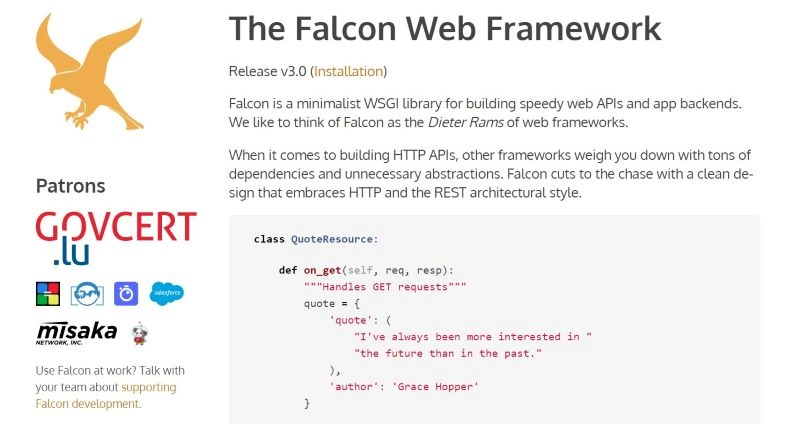
Falcon is known for its stability and efficiency, which has led to its use by LinkedIn and PayPal, among others.
Falcon's key features include the following:
- Idiomatic responses to HTTP errors
- Native support of asyncio
- ASGI, WSGI, and WebSocket support
- CPython 3.5+ and PyPy 3.5+ support
- Simple handling of exceptions
- Simple API modeling
- The optimized, expandable code base
- Cython support
Python microframework: Japronto
Japronto is another microframework that supports web development and is recommended for creating APIs and microservices.
Japronto, in particular, is recommended for creating microservices that have to handle very high loads.
It's recommended whenever extensive frameworks can't solve the problem as effectively. A lot of excitement surrounded Japronto when it was found to be able to handle a million queries per second.
Japronto is appreciated for its speed, lightness, and scalability.
Japronto's key features and advantages include the following:
- Full support for HTTP pipelining
- Synchronous and asynchronous view support
- Efficiency
- Simple routing
Python microframework: Bottle
Bottle is a Python web microframework that uses the Web Server Gateway Interface (WSGI) and is built on the Python standard library. Its characteristics include speed, ease of learning, and compatibility with APIs. It's used for building small web apps.
Bottle utilizes simple syntax, an inbuilt template engine, and acceleration enhancement to speed up the development process.
Thanks to this Python framework, developers can learn how to prototype and build web applications.
Among its most attractive features, we can find the following:
- Templating
- Plugins for multiple databases
- Single source page
- URL routing
- Ability to code closer to the hardware
- Utilities
- Abstractions
Python microframework: Hug
Embrace the APIs of the future. Hug is a microframework developed in Python 3. Its main goal is to simplify the development of Python-driven API. The framework is fast, clean, and simple, encouraging writing code that self-documents.
Key features of Hug include the following:
- Adding extensions
- Input/output handling
- Routing
- Type annotations
- Easy and intuitive API tests
- Displaying API logic through HTTP, CLI, or local function
- Version management
- Automatic documentation
Python microframework: CherryPy
A Minimalist Python Web Framework. CherryPy is an object-oriented Python web microframework.
It allows developers to access any data and templating technology. It can run sessions, file uploads, static content, cookies, and more. Moreover, it will enable us to develop web applications similar to how any other object-oriented Python program is built, which speeds up the development and results in smaller source code.
Key advantages of CherryPy include the following:
- Fast development
- Thread-pooling WSGI web server (HTTP/1.1 compliant)
- Ability to operate multiple HTTP web servers at the same time
- Integrated utilities
- Built-in support for testing, profiling, and coverage
- Plugin system
- Configuration system for developers and administrators
- Clean interface
The best Python web framework 2024. Summary
- Python and its web frameworks gain popularity every year in various studies regarding developers' programming language preferences.
- Web development and Python frameworks are almost synonymous.
- Frameworks significantly simplify and speed up the building of web applications.
- With their help, web development is much faster, simpler, and more efficient, and it guarantees better results both from the technological perspective and the business side related to the user experience.
- Web development is the creation of web applications for the Internet and intranet.
- It covers a very different range of work regarding complexity and business relevance related to user experience.
- The web development process uses a whole corpus of tools.
- Frameworks (front end, back end) provide solutions and components that are tested and constantly improved.
- Frameworks provide clear guidelines for developing applications, which reduces mistakes and eliminates the problem of reinventing the wheel.
- Python frameworks support most typical programming procedures, thus significantly reducing coding time. They also improve the code's clarity, conciseness, and simplicity, making debugging and maintenance easier.
- Front-end web development addresses the outer layer of a web application, the elements visible to users and with which they can interact.
- Back-end web development handles the back-end layer of a web application, that is, the part that is not directly accessible to website users and not visible to them.
- Frameworks developed in Python can be divided into full-stack frameworks and microframeworks.
- Full-stack frameworks allow us to create both layers of an application — front-end and back-end. The full technology stack makes it possible to develop any application.
- Microframeworks contain only the essential elements to build a simple web application.
- Python frameworks are often used to create, maintain, and develop web applications in the financial, travel, and medical industries.
- Django (full-stack framework) is recommended for developing MVPs and business applications.
- Pyramid is positioned as an alternative to full-stack and microframeworks.
- TurboGears 2 was designed and developed to solve complex performance problems.
- Grok can be used to build custom and adaptable web applications.
- Web2Py allows us to create dynamic Python web content.
- Tornado was developed for building applications requiring long-lived connections to each user.
- Flask is ideal for creating microservices offered in large web applications.
- Falcon has the advantage of being able to create projects that require special stability and efficiency.
- Japronto is recommended for creating APIs and microservices. It's particularly recommended for developing microservices that handle very high loads. It's capable of handling millions of queries per second.
- Bottle is ideal for creating small web applications and learning how to prototype.
- The Hug microframework aims to simplify the development of Python-driven API.
- CherryPy enables developers to build powerful and scalable apps with little source code.







